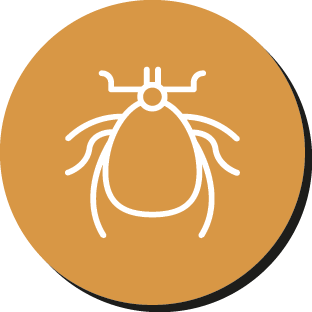Trends in Parasite Control in Pets – Europe
Parasites like fleas, ticks, mites and worms are a lifelong risk for pets. They can cause pain, discomfort, and illness and some parasites can be life-threatening for a pet if left untreated. In addition, some pet parasites and the diseases they carry are zoonotic, meaning they can be transmitted to people, putting our health and well-being in jeopardy.
Parasite control is one of the cornerstones of veterinary care and should be an essential consideration for all pet owners. Today, the risk of parasitic infestations is growing. Increased travel and cross-border movement of cats and dogs, both for trade and on holidays with their owners, combined with climate change and globalisation are enabling parasites to thrive and spread into new areas.
However, thankfully parasites in pets can be treated or even prevented. Veterinary expert groups across the world have developed guidelines for parasite control that leverage diagnostic approaches and recommendations for parasite prevention and control products alongside practical hygiene practices to reduce the risk of a parasite infestation or infection. However, surveys show a mixed picture when it comes to pet owners’ awareness of risks and adoption of recommendations to prevent parasitic infestations.
91 million European households own a pet,
46% of all households
This document outlines how the landscape for parasite control is shifting in Europe, where threats may be rising, and what can be done to better prevent parasites from harming pets and people in the future.
Parasites are a growing risk for pets
Parasites are found everywhere and can harm both pets and people if left uncontrolled, particularly as parasites spread into new areas.
Parasites are a common threat to pets across Europe
Parasites like fleas, ticks, mites and worms are a common disease risk for pets. Internal parasites can cause anaemia, diarrhoea, and respiratory issues, while external parasites can lead to skin irritation, bites, and sores. Further external parasites, especially fleas and ticks, are carriers of a variety of pathogens causing so called vector-borne diseases. Veterinary expert groups in the form of ‘parasite councils’ track parasite occurrence and have found their presence to be widespread across Europe.
A Western Europe study of city parks showed
Nematodes were detected in 57% of parks1https://parasitesandvectors.biomedcentral.com/articles/10.1186/s13071-022-05440-2

50%
An EU study found 50.7% of cats tested positive for at least one parasite2https://parasitesandvectors.biomedcentral.com/articles/10.1186/1756-3305-7-291

21%
A UK study of shelter dogs found 21% tested positive for Giardia3https://pubmed.ncbi.nlm.nih.gov/20609523/https://pubmed.ncbi.nlm.nih.gov/20609523/
Many Europeans have pets

There are over 230 million dogs and cats in Europe4https://europeanpetfood.org/wp-content/uploads/2023/06/FEDIAF_Annual-Report_2023_Facts-Figures.pdf and it is estimated that there are a billion pets worldwide. The rise in pet numbers is driven by younger generations, more people living alone, and a growing middle class in low- and middle-income countries. Pets provide companionship and comfort but can also serve as a ‘reservoir’ for parasites and associated pathogens if not properly controlled.
Increasing prevalence and geographic spread of vector-borne disease
Vector-borne diseases are illnesses that are caused by pathogens that are transmitted by parasites to people and animals. An expansion of endemic areas5https://www.esccap.org/uploads/docs/5y4xn3fr_0775_ESCCAP_Guideline_GL5_20221228_1p.pdf (where the disease is commonly present) has been recorded for various parasitic diseases such as dirofilariosis, babesiosis and leishmaniosis. Evidence points to the spread and (re-)emergence of leishmaniosis in humans in some endemic areas. Furthermore, ECDC states that leishmaniases remain widespread and underreported in many countries of southern Europe and northern Africa, and insufficient prevention and control measures could lead to an increase in incidence in the EU.6https://www.ecdc.europa.eu/sites/default/files/documents/leishmaniasis-surveillance-eu.pdf
Geographical distribution of reported animal leishmaniasis cases, European Union and neighbouring countries, 2009−20207https://www.ecdc.europa.eu/sites/default/files/documents/leishmaniasis-surveillance-eu.pdf

Global phenomena like climate change are helping parasites thrive
Factors such as climatic and ecological changes alongside global travel and translocation of pets are helping parasites to spread and thrive in regions where they may not have been present in the past. This means more pets are at risk and veterinarians must stay up-to-date on parasite threats in their area.

The UK’s ‘Tick Surveillance Scheme’ shows canine travel from EU countries into the UK is directly connected to the arrival of new tick species8https://pubmed.ncbi.nlm.nih.gov/29217768/

A study in Northern Italy found some sand flies have ‘increased in density and expanded their geographic range’9https://pubmed.ncbi.nlm.nih.gov/18304273/
Between 2008 and 2020 ‘Hungary became a heartworm endemic country’, with ‘emergence of dirofilaria immitis mainly explained by the warming climate’10https://www.sciencedirect.com/science/article/abs/pii/S0304401720300479?via%3Dihub

A global study found that ‘climate change is projected to continue to contribute to the spread of Lyme disease and tick-borne encephalitis, particularly in North America and Europe11https://pubmed.ncbi.nlm.nih.gov/35585385/

Pets can transmit parasites to people
When pets are not protected, the surrounding household is at greater risk
Some of the parasites that harm pets can also infest or infect people. Parasites like fleas can lead to household infestation and it takes months of intensive cleaning to clear households from these pests. Fleas, ticks, or mosquitoes can also transmit pathogens causing illness (also known as vector-borne disease) to pets and people alike. Controlling parasites in pets remains today’s cornerstone to mitigate and control One Health threats posed by these parasites both for the animals and the surrounding household and community.

Between 2009 and 2016 there were more than 700 new clinical cases reported of Human Leishmaniosis in Madrid caused by L. infantum, with dogs being the main reservoir of infection.12https://www.esccap.org/uploads/docs/5y4xn3fr_0775_ESCCAP_Guideline_GL5_20221228_1p.pdf


If prevention products are not used, a household flea infestation requires 3 months to eliminate, according to the European Scientific Counsel for Companion Animal Parasites.13https://www.esccap.org/uploads/docs/oqsb8b7j_0687_ESCCAP_General_Recommendations_update_v5.pdf

Parasites increase the burden of disease and may cause serious harm in people
‘Zoonotic’ parasites affect both people and pets, spreading illness and causing physical harm like bites.
This can pose a serious risk to people, particularly for children, the elderly or immunocompromised groups.
Vector-borne diseases represent 17% of all infectious diseases worldwide, causing
700,000 human deaths annually.14https://www.who.int/news-room/fact-sheets/detail/vector-borne-diseases
Parasites & parasitic diseases cause serious harm in people
Four Zoonotic Parasite Threats

Ticks
Can infect pets and people with diseases such as Lyme disease and ehrlichiosis.

Sandflies
Can spread Leishmania, a potentially deadly disease, involving fever, sores, and organ issues.

Fleas
Year-round issue, causing bites, skin irritations, and itching with the ability to transmit zoonotic pathogens, such as Dipylidium caninum and Bartonella henselae.

Toxocara
Main cause of human toxocariasis, can lead to myocarditis, respiratory failure, ocular and vision problems.
Lyme disease is the most common tick-borne disease in Europe, with an average
128,888
cases reported annually15https://pubmed.ncbi.nlm.nih.gov/37071405/
24%
of patients hospitalised with leishmaniosis between 1997 and 2011 in Spain were under 15 years old16https://www.ecdc.europa.eu/sites/default/files/documents/leishmaniasis-surveillance-eu.pdf
1 in 4
cats and 1 in 7 dogs in the UK have fleas17https://parasitesandvectors.biomedcentral.com/articles/10.1186/s13071-019-3326-x
A study showed
50%
of Lisbon public parks and
85.7%
of sandpits were contaminated with Toxocara18https://pubmed.ncbi.nlm.nih.gov/28545900/
Parasites can be prevented
Parasite control in pets is essential considering the risk it can pose to the animal and the surrounding household. ‘Parasite Councils’ such as the European Scientific Counsel for Companion Animal Parasites (ESCCAP) provide expert independent guidelines on effective parasite management. Local authorities and veterinary associations also provide guidance for pet owners to protect their animal.
Although the specific advice will depend on the local situation and therefore differ by country, all experts generally agree that the best way to protect pets and ourselves is to prevent parasites and parasite-transmitted pathogens from establishing themselves in the first place. A few areas that are often recommended include:
Experts like the European Scientific Counsel for Companion Animal Parasites recommend ‘good hygiene’ as a simple way to reduce the chances your pet will spread certain parasites that might infect people and other animals. Recommendations for vets to educate clients developed by ESCCAP19https://www.esccap.org/uploads/docs/oqsb8b7j_0687_ESCCAP_General_Recommendations_update_v5.pdf include:
Hygiene measures

Review parasite control in pets at least every 12 months as part of an annual health check.

Advise the client to cover sandpits when not in use.

Stress the importance of thoroughly washing all fruit and vegetables before eating.

Encourage hand hygiene, especially in children.

Advise the client against feeding unprocessed raw meat diets to pets and encourage the provision of fresh water.

Advise the client to pick up faeces immediately from gardens and when dog walking and to wash their hands afterwards. Stress that dog and cat waste should not be composted if compost is intended for edible crops.
Graphic adapted from ESCCAP Guidelines
Use of parasite prevention and control products
Parasite prevention and control products can help pet owners to manage a variety of parasites like heartworm, intestinal parasites, fleas and ticks and prevent them from infesting an animal or treat already infested pets. Veterinarians will recommend products and approaches that match a pet’s risk level of parasite infestation. These products are usually available from veterinarians, pharmacies and depending on national legislation from other retailers such as pet shops.
Examples of guidance20https://www.esccap.org/page/GL3+Control+of+Ectoparasites+in+Dogs+and+Cats/27/ include:

Fleas
“In areas where re-infestation with fleas is highly likely, such as warm conditions and multiple animal households, regular prophylaxis (prevention) using an approved product is recommended. While flea infestations peak in summer and autumn, studies have shown that flea infestation can occur throughout the year, thus year-round flea control might be necessary.”

Ticks
“Tick prophylaxis should cover the entire period during which ticks are active. Depending on the level of risk and local legislation, this may consist of regular checking of the pet for ticks and/or acaricidal treatment. Dogs and cats that are travelling to regions with ticks and endemic tick-borne diseases should also receive a regular application of acaricidal products, particularly if these tick-borne diseases are not endemic in their home country.”
Diagnostic Testing
Regular testing for various parasites or associated diseases can help to determine the health status. This gives valuable information about infections and can support the development of a parasite control strategy. It can also indicate whether the strategy selected by the owner and veterinarian is working and can help ensure compliance. For example, two types of tests that can be conducted are:

Blood test: Diagnostic tools can check for life-threatening parasites such as heartworm and vector-borne diseases like Lyme disease and ehrlichiosis.

Fecal exam: Microscopic, antigen or DNA fecal testing can detect the presence of parasites such as Giardia, hookworms, roundworm, and tapeworms. Many are zoonotic, raising the risk to a pet’s household and the surrounding community.
Every pet owner will require their own mix of actions to address the unique risk of parasites to their animal. Hygiene, parasite prevention products and diagnostic testing typically play a role based on the recommendations of experts, however determining the exact mix requires consultation with a veterinarian. Ensuring pets regularly see their veterinarian must be at the core of any parasite control strategy.
There are significant opportunities to increase awareness of parasite risk and compliance with prevention measures
Some surveys show that pet owners are not fully aware of the risk of parasites to their animals as well as to themselves. and many are not in compliance with recommended prevention practices by local veterinarians. This highlights a significant need for greater communication with pet owners and promotion of parasite control by veterinarians, policymakers, and other key voices.
Pet Owner Survey Results
Percentage of French pet owners in compliance with best practices in deworming21https://parasitesandvectors.biomedcentral.com/articles/10.1186/s13071-019-3712-4

Graphic reproduced from study, French national survey of dog and cat owners on the deworming behaviour and lifestyle of pets associated with the risk of endoparasites.
Only 16% of dogs in the Netherlands adhere recommended deworming practices22https://pubmed.ncbi.nlm.nih.gov/25468379/
97% of UK dogs are in the highest risk category for parasites, yet only 8.6% meet recommended deworming practices23https://doi.org/10.1186/s13071-020-04086-2
Only 5.5% of Portuguese cats meet the recommended deworming treatment regiment24https://www.sciencedirect.com/science/article/abs/pii/S0167587715300118
95% of dogs and 39% of cats in Spain are dewormed less often than recommended25https://www.ncbi.nlm.nih.gov/pmc/articles/PMC7045513/
More information on parasite control in pets
Pet owners should always consult with their veterinarian for the ideal strategy to control parasites in their animals. Furthermore, companion animal parasite councils in major regions can offer important guidelines for proper control.



